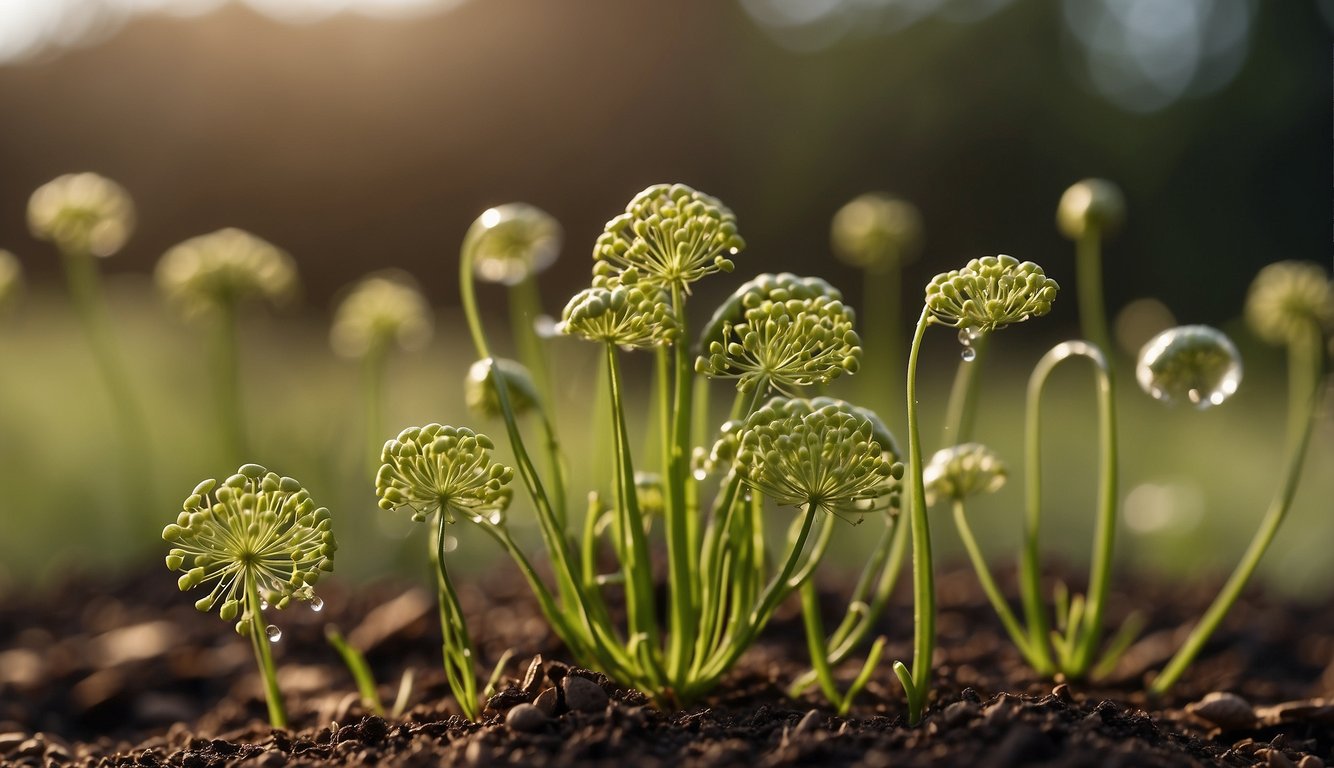TheHerbProf.com is a treasure trove of knowledge for those interested in natural healing and herbal remedies. The website is run by Paul Johnston MD. A naturopathic who has not only received extensive education in the field but also has personal experience in self-healing.
Propagating dill is a great way to ensure a steady supply of this flavorful herb. Dill is an annual herb that is easy to grow and propagate. It is commonly used in pickling, soups, dressings, and potato dishes. Propagating dill from cuttings is a simple and effective way to grow new plants.
To propagate dill from cuttings, select healthy cuttings that are about 4-5 inches long with at least 3 sets of nodes along their length. Make sure they are free from disease or pests before snipping them off with sharp scissors. Disinfecting blades between cuts is also recommended for cleanliness sake. Once you have your cuttings, place them in a jar of water and set them in a sunny window. Change the water every few days to keep it fresh and clean. Within a week or two, you should see roots starting to form.
Another way to propagate dill is by planting seeds directly in soil. Dill seeds can be sown directly into the soil in the spring or fall. Dill prefers a sunny location and well-draining soil. Water the seeds regularly until they germinate and the plants are established. Once the plants are established, they require little maintenance and will continue to grow throughout the season.
Understanding Dill
Dill (Anethum graveolens) is a popular herb that belongs to the Umbelliferae family. It is an annual plant that grows up to three feet tall and has long, thin leaves. Dill is known for its distinct flavor, which is used in many dishes such as salads, sauces, and pickles. In this section, I will discuss the characteristics of dill, its culinary uses, and its health benefits.
Characteristics of Dill
Dill has a unique flavor that is often described as tangy and slightly sweet. It has a strong aroma that is similar to that of caraway. The leaves of dill are delicate and feathery, and they have a bright green color. Dill plants produce small yellow flowers that bloom in the summer. These flowers are followed by seeds that are often used for pickling.
Culinary Uses of Dill
Dill is a versatile herb that is used in a variety of culinary applications. It is commonly used in salads, dressings, and sauces. Dill is also a popular herb for pickling, as its flavor complements the sourness of the pickling brine. Dill can be used to flavor fish, poultry, and vegetables. It is often used in Mediterranean and Scandinavian cuisines.
Health Benefits of Dill
Dill has several health benefits. It is rich in antioxidants, which can help to reduce inflammation and protect against chronic diseases. Dill is also a good source of vitamin C, which is important for immune function. Additionally, dill has been used in aromatherapy to promote relaxation and reduce stress.
Dill is a versatile herb that has a unique flavor and several health benefits. It is commonly used in culinary applications such as salads, dressings, and pickling. Dill is also a good source of antioxidants and vitamin C, and it has been used in aromatherapy to promote relaxation.
Starting with Seeds – How to Propagate Dill?
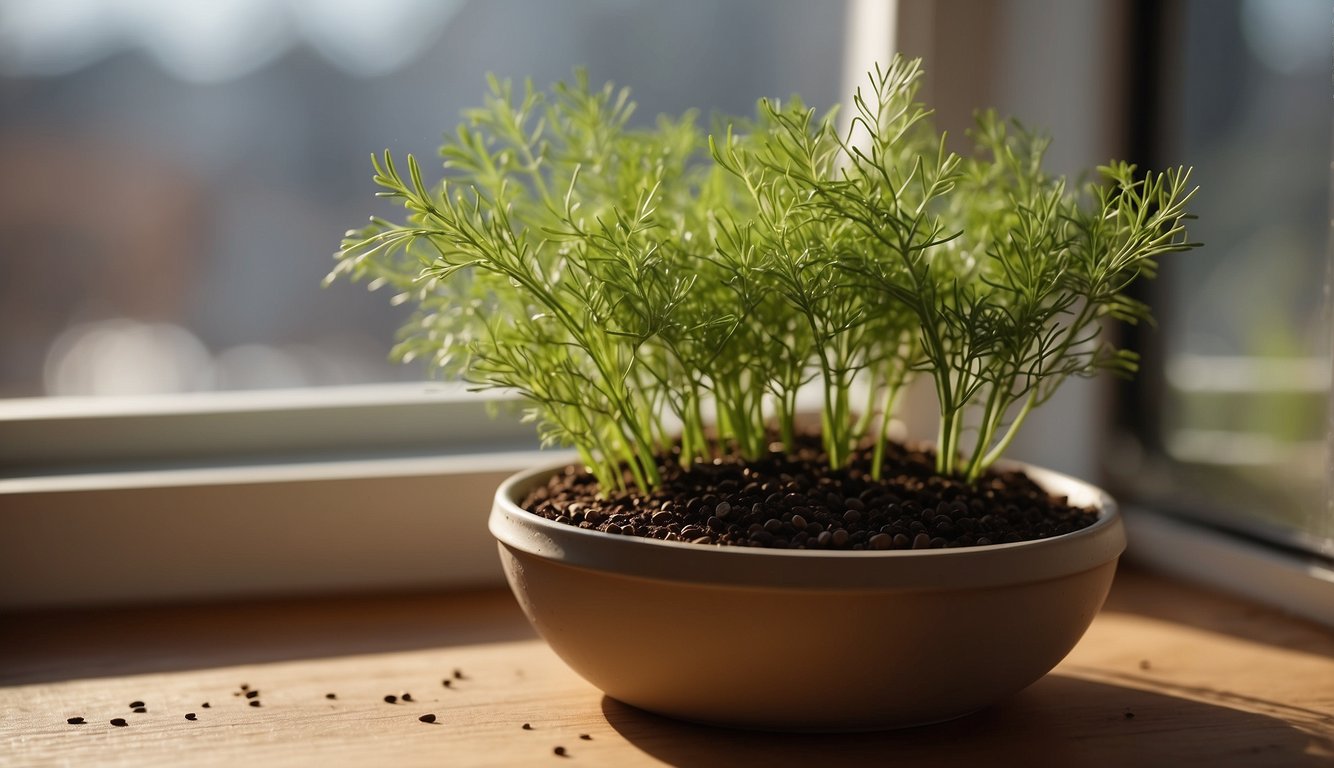
Growing dill from seed is easy and rewarding. Here are some tips to help you get started.
Choosing the Right Seeds – How to Propagate Dill?
When choosing dill seeds, look for high-quality seeds that are fresh and viable. You can buy seeds online or from your local garden center. Organic seeds are a good choice if you want to avoid pesticides and other chemicals.
Seed Planting Depth and Spacing
Dill seeds should be planted about ¼ inch deep in well-draining soil. Space the seeds about 12 inches apart. Dill has a long taproot, so it’s best to plant it in a deep container or directly in the ground.
Germination Conditions
Dill seeds will germinate in 7-14 days if the conditions are right. The ideal temperature for germination is between 60-70°F (15-21°C). Keep the soil moist but not waterlogged. Dill needs plenty of light to germinate, so make sure to place it in a sunny spot or under grow lights.
During the growing season, dill needs at least 6 hours of direct sunlight per day. Water the plants regularly, but be careful not to overwater them. Dill prefers a slightly acidic soil with a pH between 5.5 and 6.5.
With these tips, you should be able to grow dill from seed with ease.
Propagation by Cuttings – How to Propagate Dill?
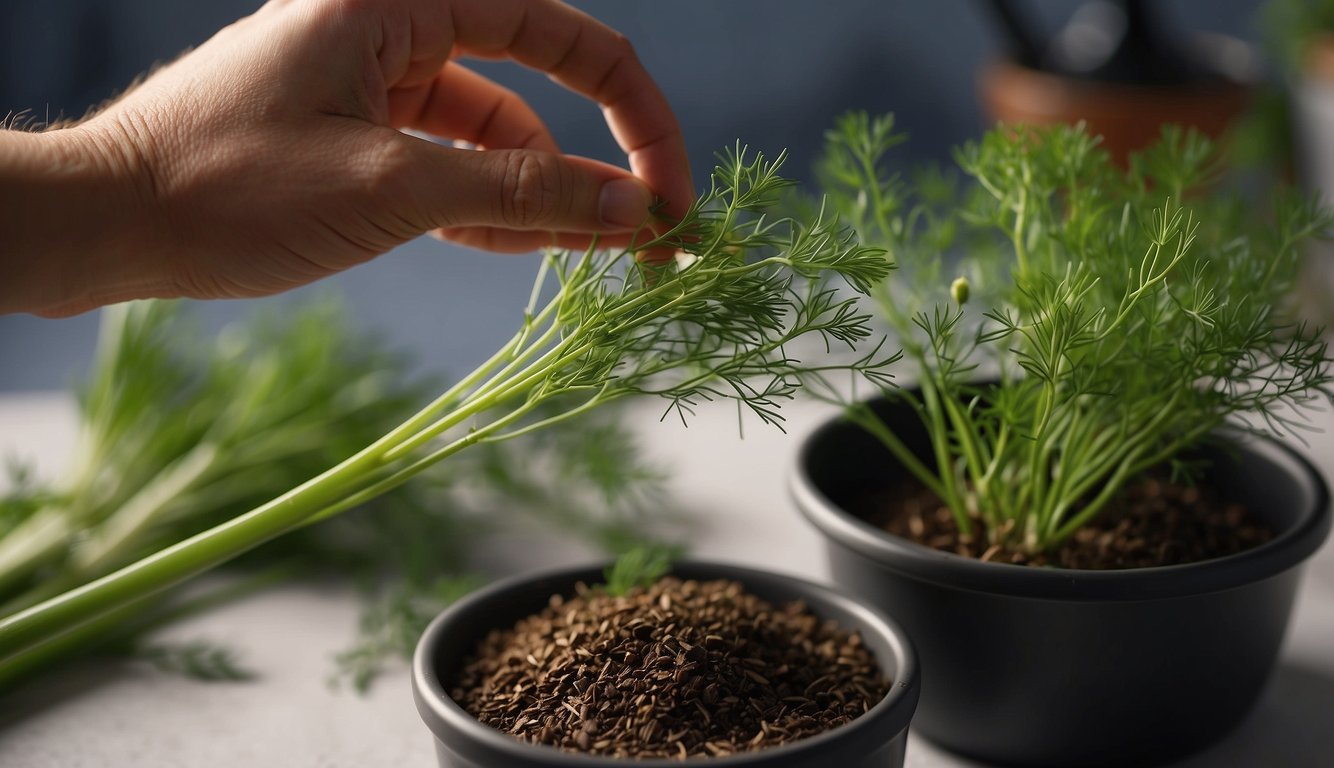
When it comes to propagating dill, one of the easiest and most effective methods is through cuttings. This method involves taking a stem from a mature dill plant and rooting it to create a new plant. Here are the steps to propagate dill by cuttings:
Taking Dill Cuttings
The first step in propagating dill by cuttings is to select a healthy parent plant. Look for a mature dill plant that has plenty of lush, green foliage. Choose stems that are free from disease or damage. Using sharp scissors, take cuttings from the parent plant that are approximately 4-6 inches long. Make sure to cut the stem just below a leaf node, which is where the leaf meets the stem.
Rooting Dill Cuttings
Once you have taken your dill cuttings, it’s time to root them. Fill a jar or glass with water and place the cuttings in the jar so that the bottom of the stem is submerged in the water. Make sure to change the water every few days to keep it fresh. Place the jar in a bright, sunny spot, but avoid direct sunlight as this can cause the water to heat up and harm the cuttings.
After a few weeks, you should start to see roots growing from the bottom of the stem. Once the roots are a few inches long, you can transplant the cuttings into soil. Make a small hole in the soil and gently place the cutting in the hole. Cover the roots with soil and gently compact it around the stem. Water the soil and keep it moist until the cutting has established a strong root system.
When propagating dill by cuttings, it’s important to use sharp scissors to avoid damaging the stem. Additionally, make sure to change the water in the jar every few days to keep it fresh and prevent the growth of harmful bacteria. With these tips in mind, you should be able to successfully propagate dill by cuttings and enjoy a bountiful harvest of this flavorful herb.
Transplanting Dill – How to Propagate Dill?
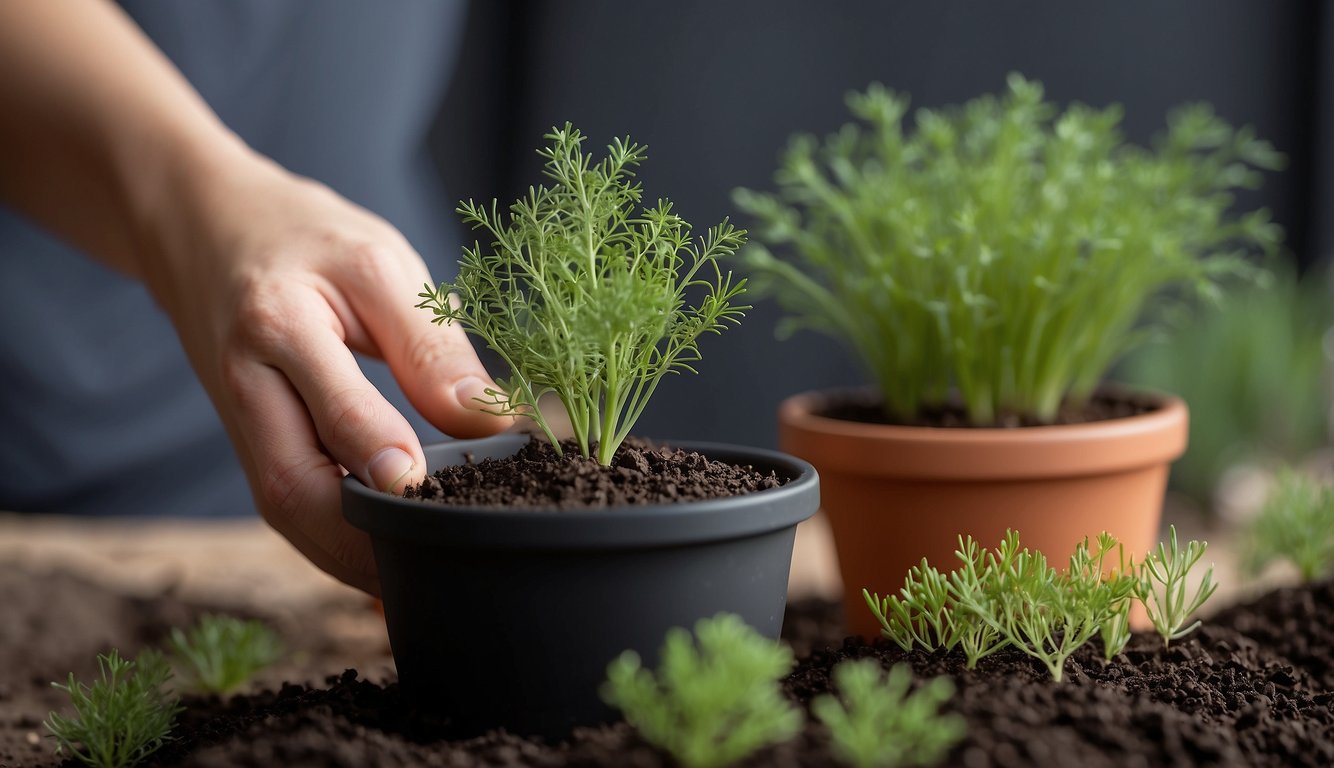
When to Transplant – How to Propagate Dill?
When your dill plant has outgrown its current container or spot in the garden, it’s time to transplant it. Dill plants have a taproot, so it’s important to transplant them before the taproot becomes too long and gets damaged during the transplanting process.
Preparing the Transplant Site
Before transplanting your dill plant, prepare the new site. Choose a location that receives full sun and has well-draining soil. If transplanting to a container, make sure it has drainage holes and is large enough to accommodate the root system. Fill the container with well-draining soil, leaving enough space at the top for the dill plant.
Transplanting Steps
To transplant your dill, gently remove it from its current container or spot in the garden, being careful not to damage the taproot. Place the dill plant in the new hole, making sure that the top of the root ball is level with the surrounding soil. Fill in the hole with soil, gently pressing down to remove any air pockets. Water the dill plant thoroughly, making sure the soil is moist but not waterlogged.
If transplanting to a container, make sure to water the dill plant regularly and keep it in a sunny location. If transplanting to the garden, water the dill plant regularly until it becomes established in its new location.
Overall, transplanting dill is a straightforward process that can be done successfully with the right preparation and care. By following these steps, you can ensure that your dill plant continues to thrive in its new location.
Dill Care and Maintenance – How to Propagate Dill?

Growing dill is easy, but it requires proper care and maintenance to thrive. In this section, I will discuss the watering, sunlight and temperature requirements, soil and fertilization, pruning, and harvesting of dill.
Watering and Moisture – How to Propagate Dill?
Dill prefers moist soil but not wet. Overwatering can lead to root rot, so it’s important to ensure proper drainage. Water your dill regularly, especially during hot summer days, to keep the soil moist. I recommend watering the plant once a week or more often if the soil feels dry to the touch.
Sunlight and Temperature Requirements
Dill loves sunlight and warm temperatures. It grows best in full sun, but it can tolerate partial shade. The ideal temperature range for dill is between 60-70°F (15-21°C). During hot summer days, it’s important to provide some shade to prevent the plant from wilting.
Soil and Fertilization
Dill grows best in well-draining potting soil. Ensure that the soil has good drainage to prevent waterlogging. Fertilize your dill every three weeks during the growing season with a balanced fertilizer. You can also add compost to the soil to improve its fertility.
Pruning and Harvesting
Pruning is essential to keep your dill plant healthy and bushy. Pinch off the growing tip of the plant when it reaches a height of 12-18 inches to encourage bushier growth. Harvest the leaves and stems of the plant when they are young and tender. Cut the foliage close to the stem to encourage new growth.
Dill is an easy-to-grow herb that requires proper care and maintenance to thrive. By following the tips outlined in this section, you can ensure that your dill plant stays healthy and productive throughout the growing season.
Pest and Disease Management – How to Propagate Dill?
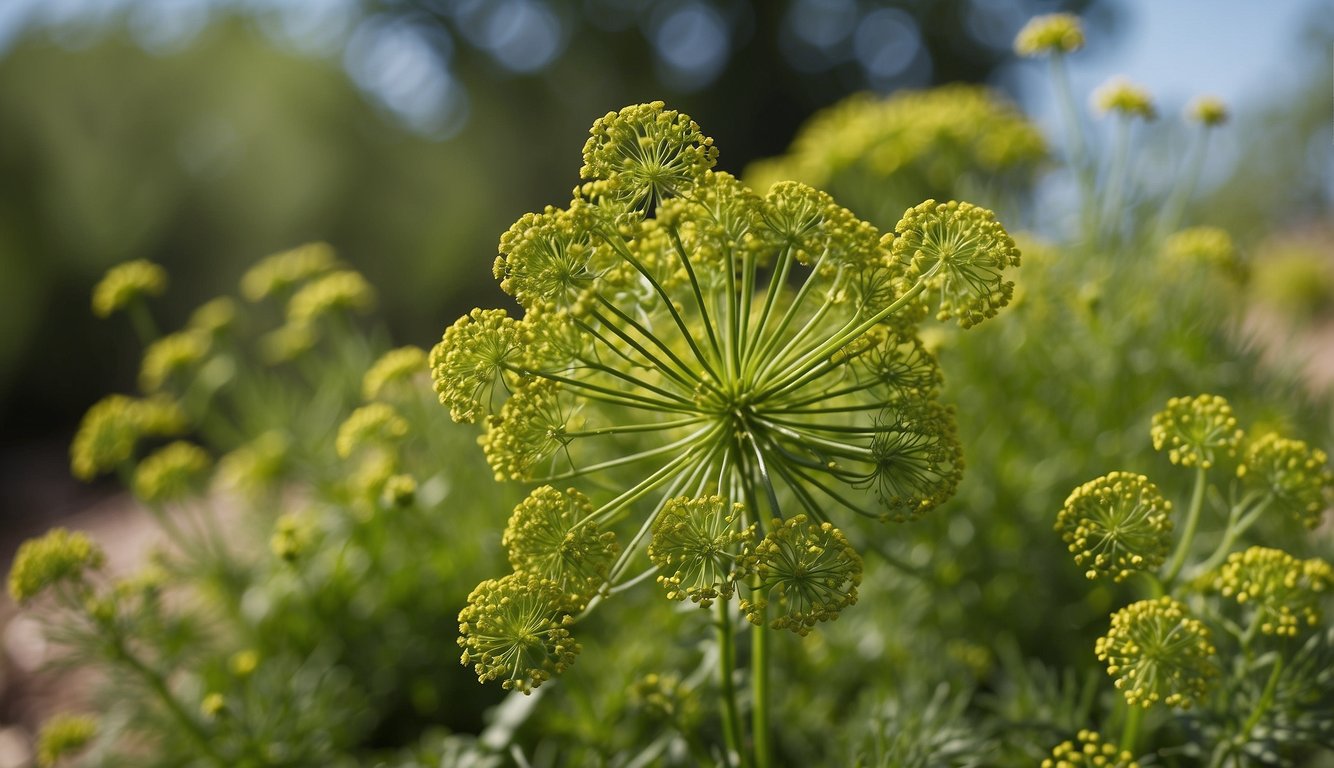
As a responsible gardener, I always take preventive measures to keep my dill plants healthy and free from pests and diseases. In this section, I will share some tips on how to manage pests and diseases that commonly affect dill plants.
Common Pests – How to Propagate Dill?
Aphids and spider mites are common pests that can infest dill plants. Aphids are small, pear-shaped insects that suck the sap from the leaves and stems of the plant. Spider mites are tiny arachnids that also feed on the sap of the plant and can cause yellowing and wilting of leaves.
To prevent these pests from infesting your dill plants, you can spray them with a mixture of water and dish soap. This solution will suffocate the pests and prevent them from spreading. You can also introduce beneficial insects like ladybugs and lacewings that feed on aphids and spider mites.
Disease Prevention and Control
Diseases like root rot and caterpillar infestations can also affect dill plants. Root rot is caused by overwatering and poor drainage, which can lead to the decay of the plant’s roots. Caterpillars can chew on the leaves and stems of the plant, causing damage and reducing the plant’s yield.
To prevent root rot, make sure that your dill plants are planted in well-draining soil and avoid overwatering. You can also add organic matter like compost to the soil to improve drainage and provide nutrients to the plant.
To control caterpillar infestations, you can handpick the caterpillars and remove them from the plant. You can also spray the plant with a mixture of water and neem oil, which is a natural insecticide that repels caterpillars and other pests.
By following these tips, you can keep your dill plants healthy and free from pests and diseases. Remember to always monitor your plants and take action at the first sign of infestation or disease.
Using Containers for Dill – How to Propagate Dill?
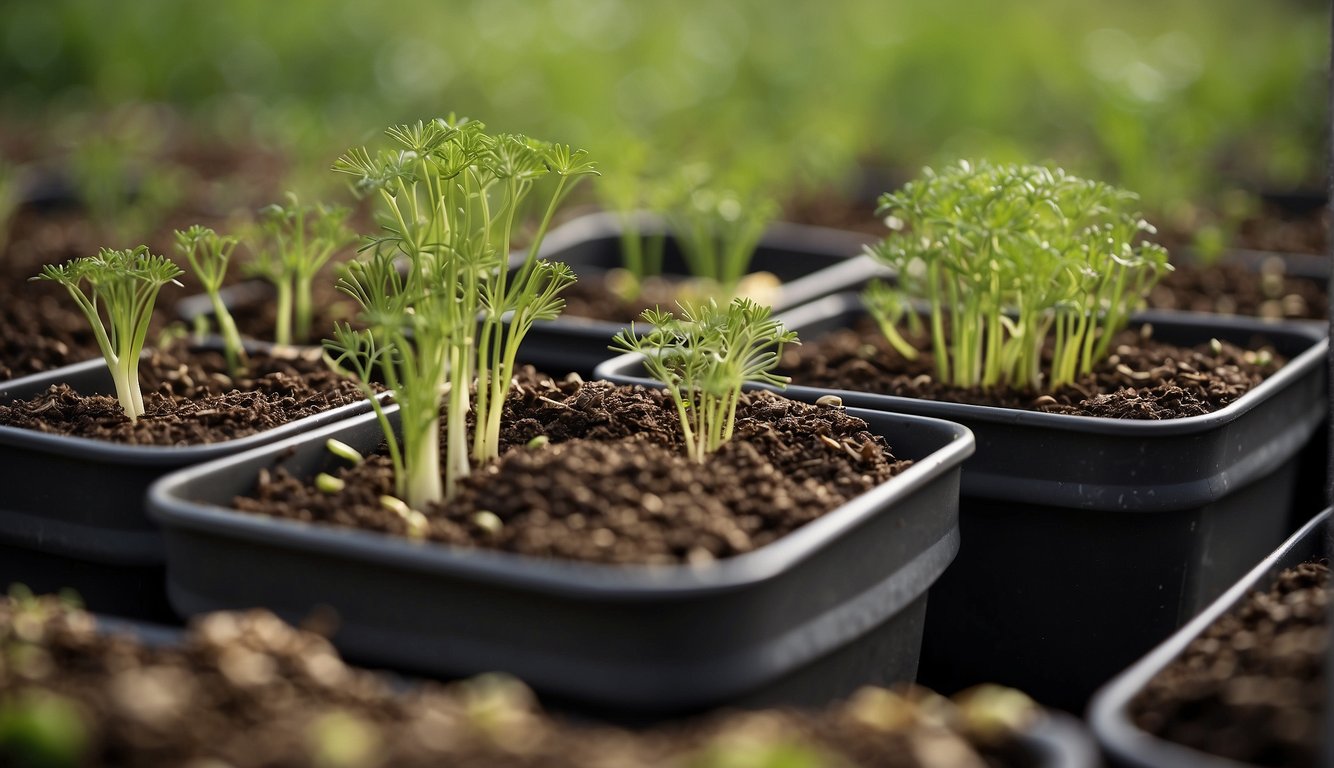
Growing dill in containers is an excellent option for gardeners with limited space or who want to grow dill indoors. Containers are also useful for those who want to move their dill plants around to get the best sun exposure. In this section, I will cover the basics of using containers for dill, including choosing the right container and potting mix, and ensuring proper drainage.
Choosing the Right Container
When choosing a container for dill, it’s important to consider the size of the plant at maturity. Dill can grow up to three feet tall, so a container that is at least 12 inches deep and 12 inches wide will provide enough space for the plant to grow. It’s also important to choose a container with drainage holes to prevent waterlogging and root rot.
Containers can be made of various materials, including plastic, clay, or wood. Plastic containers are lightweight and easy to move around, while clay containers are more porous and can help regulate moisture levels. Wooden containers can be attractive but may require more maintenance.
Potting Mix and Drainage
Choosing the right potting mix is essential for growing dill in containers. A well-draining soil mix will prevent water from pooling at the bottom of the container and ensure that the roots have access to oxygen. A good potting mix should contain a combination of peat moss, vermiculite, and perlite.
When planting dill in containers, make sure to fill the container with the potting mix up to an inch below the rim. This will allow for proper watering without the soil overflowing. Water the soil thoroughly until water comes out of the drainage holes, then allow the soil to dry out slightly before watering again.
In summary, growing dill in containers is a great way to enjoy fresh herbs in a limited space. When choosing a container, make sure it is deep and wide enough for the plant to grow, and has proper drainage holes. Use a well-draining potting mix to ensure the roots have access to oxygen, and water the soil thoroughly while allowing it to dry out slightly between waterings.
Companion Planting and Ecology – How to Propagate Dill?
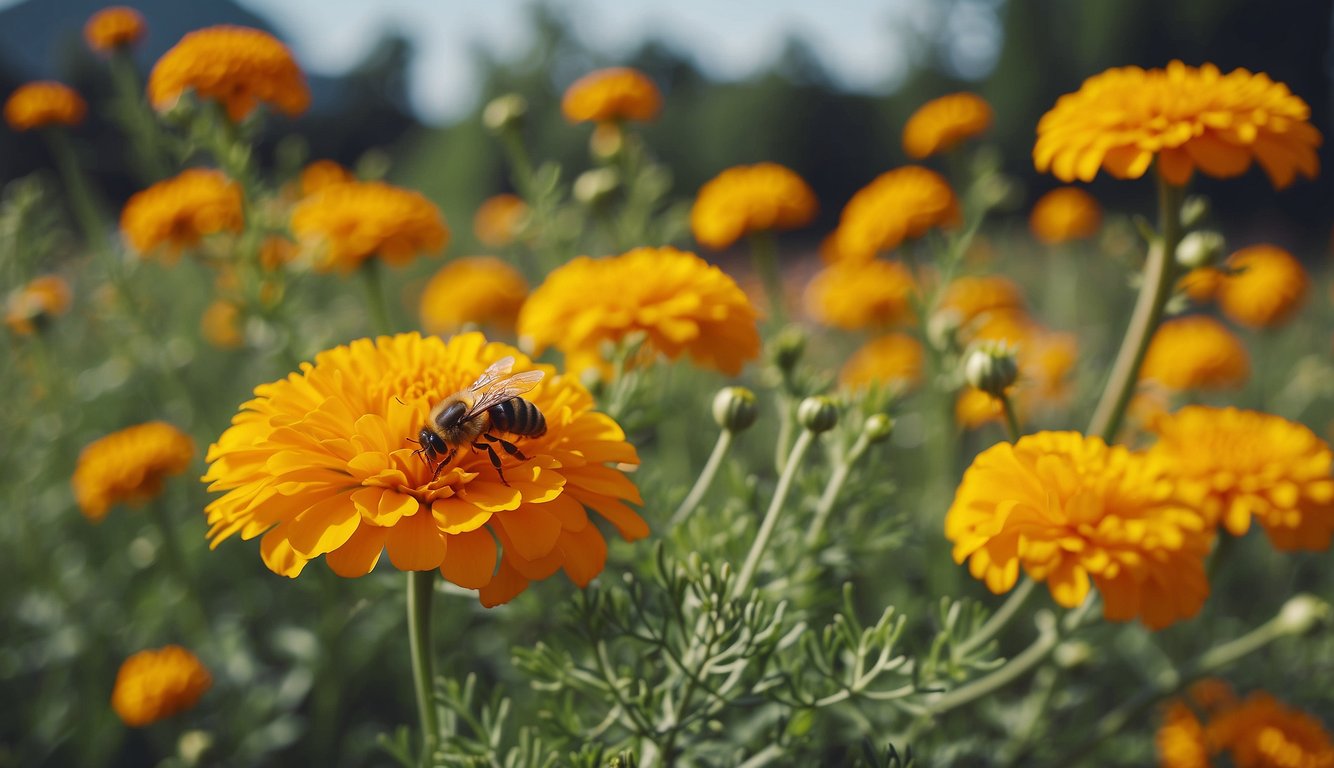
When it comes to propagating dill, companion planting is an excellent way to promote the health of your garden. Companion planting is the practice of growing different plants together to benefit each other. By planting dill alongside certain vegetables and herbs, you can create a mutually beneficial ecosystem that promotes plant growth and attracts beneficial insects.
Beneficial Insects and Dill
Dill is a natural insect repellent and attracts beneficial insects such as ladybugs, lacewings, and parasitic wasps. These insects help control pests that can damage your garden, such as aphids, caterpillars, and mites. Planting dill alongside cucumbers, carrots, and other vegetables can help repel pests and promote plant growth.
Companion Vegetables and Herbs – How to Propagate Dill?
In addition to attracting beneficial insects, dill also makes an excellent companion plant for certain vegetables and herbs. Planting dill alongside cabbage, broccoli, and other brassicas can help repel pests and promote plant growth. Dill also pairs well with other herbs in the herb garden, such as parsley and cilantro.
When it comes to culinary use, dill adds a unique flavor to salads and can be used in a variety of dishes. Spring is the perfect time to propagate dill, and it can be grown both indoors and outdoors. With its many benefits, dill is a valuable addition to any garden.
Harvesting and Storing Dill
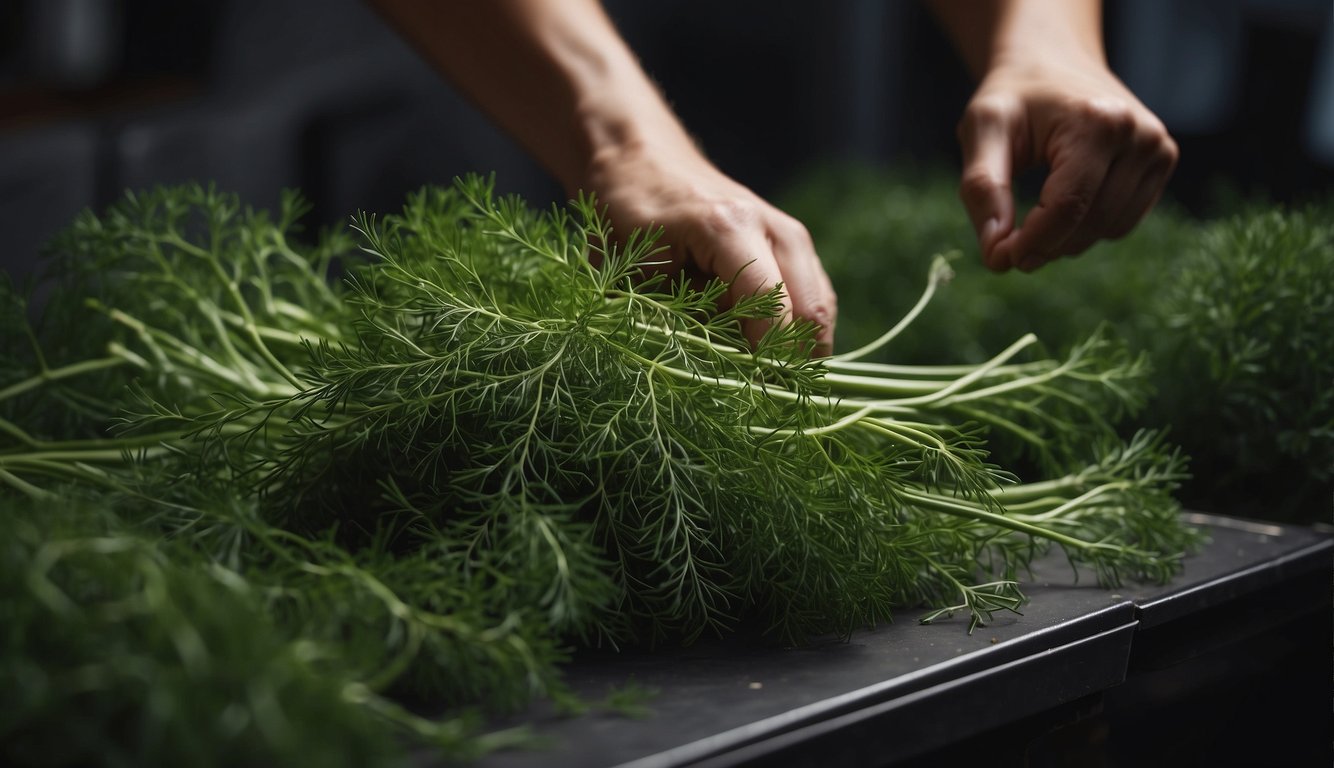
Dill is a versatile herb that can be used in a variety of recipes such as sauces, pickles, soups, and stews. Harvesting and storing dill properly is essential to ensure its freshness and flavor. In this section, I will explain the best techniques for harvesting dill, how to store it for freshness, and how to use it in recipes.
Harvesting Techniques – How to Propagate Dill?
To harvest dill, use a pair of scissors or pruning shears to cut the leaves and stems from the plant. Cut the stems just above the base of the plant to encourage new growth. Make sure to leave some leaves on the plant to allow it to continue growing. Harvest dill when it is young and tender, as older plants can become woody and tough.
Storing for Freshness
To store dill for freshness, wrap the leaves and stems in a damp paper towel and place them in a plastic bag. Store the bag in the refrigerator for up to one week. Alternatively, you can freeze dill by chopping it finely and placing it in ice cube trays with water. Once frozen, transfer the cubes to a plastic bag and store in the freezer for up to six months.
Dill in Recipes
Dill is a versatile herb that can be used in a variety of recipes. It pairs well with fish, chicken, and vegetables. Use dill to make sauces such as tzatziki or ranch dressing, or add it to pickles for a tangy flavor. Dill can also be used to flavor soups and stews, or sprinkled over roasted vegetables for a fresh and aromatic touch.
Harvesting and storing dill properly is essential to ensure its freshness and flavor. Use the techniques outlined in this section to harvest dill, store it for freshness, and use it in a variety of recipes.
Advanced Propagation Techniques – How to Propagate Dill?
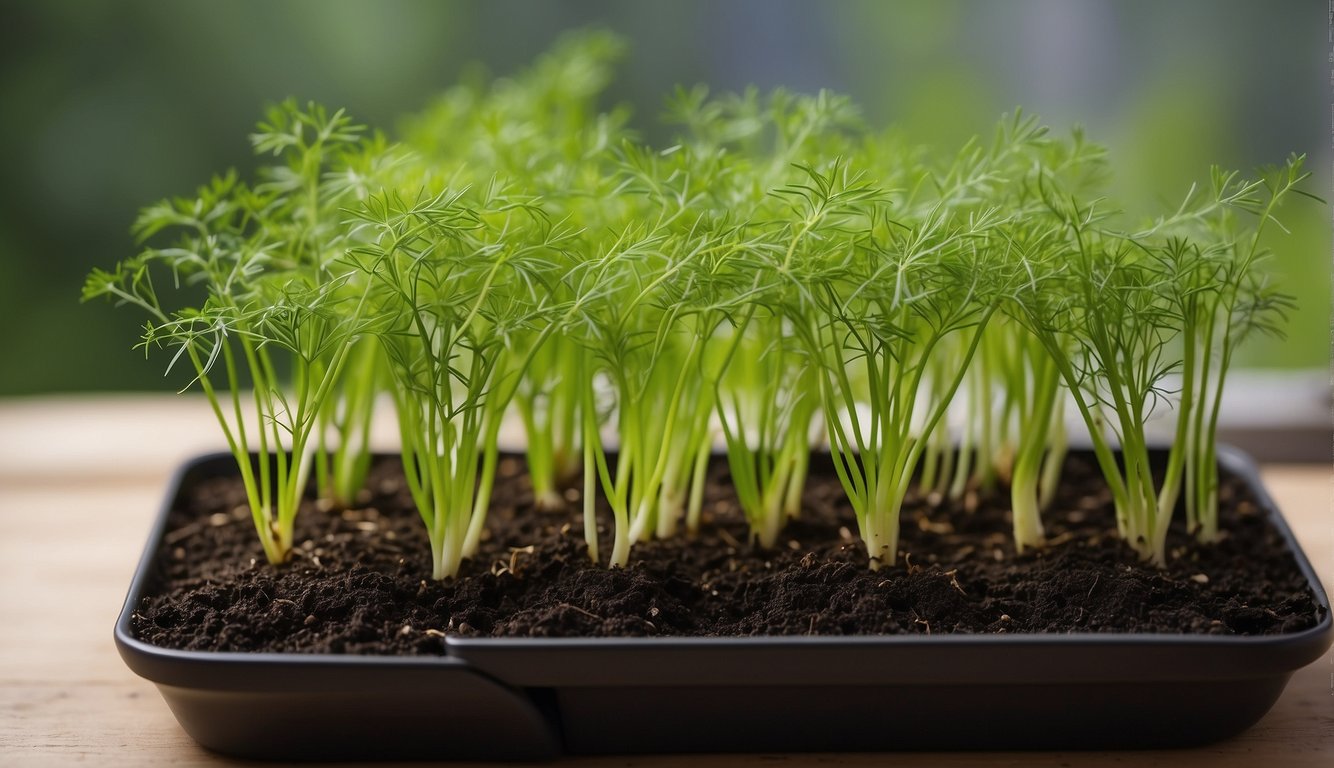
If you are looking to take your dill propagation skills to the next level, there are a few advanced techniques you can try. These methods are best attempted by experienced gardeners who are comfortable with propagating plants.
Layering Methods
Layering is a propagation technique that involves encouraging a stem to root while it is still attached to the parent plant. This can be done by burying a section of the stem in soil or by using a rooting hormone to encourage root development.
To layer dill, select a healthy stem from the parent plant and bend it down to the ground. Make a small cut in the stem where it touches the soil, then cover the cut section with soil. Keep the soil moist and wait for roots to develop. Once roots have formed, you can cut the stem from the parent plant and transplant it to a new location.
Division of Mature Plants – How to Propagate Dill?
Another advanced propagation technique is to divide mature dill plants. This method is best used on plants that are at least one year old and have a well-established root system.
To divide a mature dill plant, carefully dig it up and separate the root ball into two or more sections. Each section should have its own set of leaves and roots. Replant each section in a new location and water thoroughly.
While these advanced propagation techniques can be challenging, they can also be rewarding. By experimenting with different methods, you can develop your skills as a gardener and increase your success rate when growing dill from cuttings.
Seasonal Dill Growing Tips
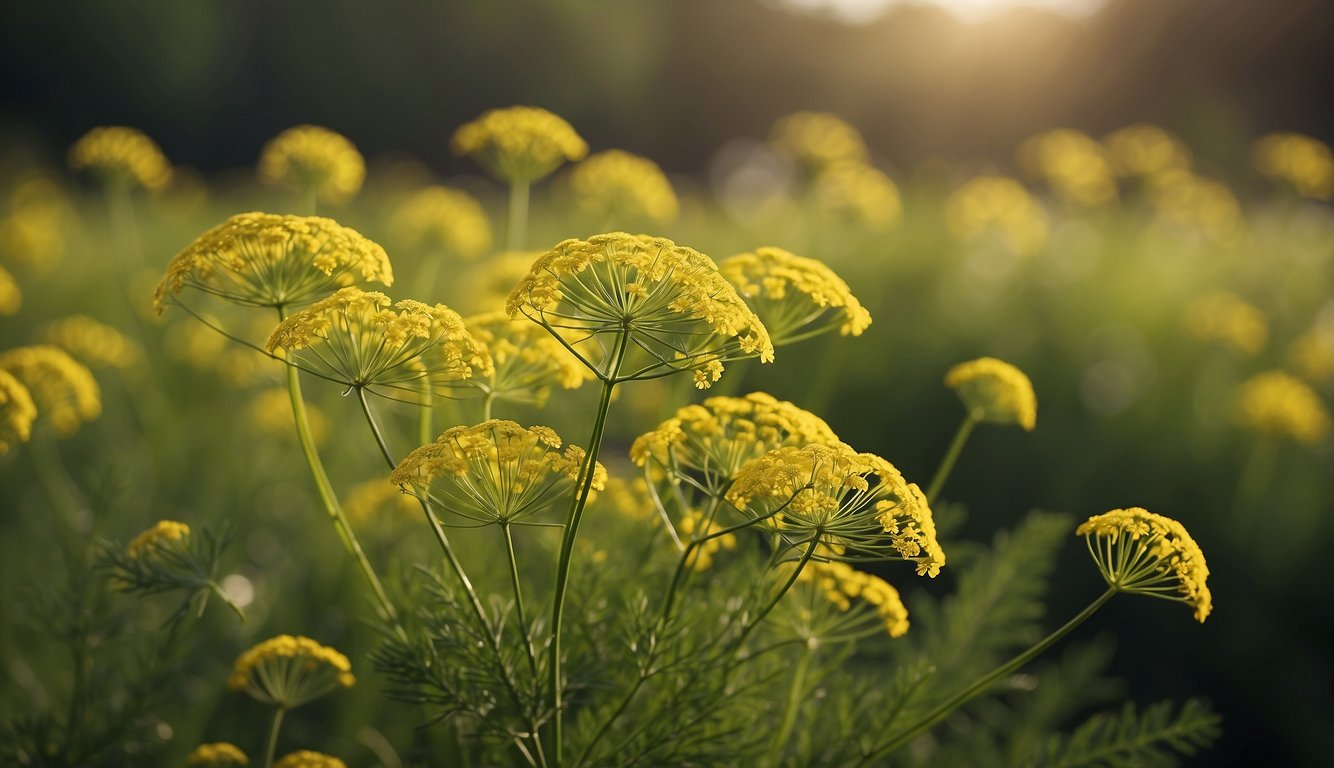
As an avid dill grower, I have learned a few tips and tricks to ensure a bountiful harvest. Here are some seasonal tips for growing dill that I have found to be effective.
Spring Planting Guide – How to Propagate Dill?
Spring is the perfect time to plant dill. After the last frost, sow the seeds directly into the soil, placing them 1/4 inch deep and about 1 to 2 inches apart. Plant the seeds in rows about 6 inches apart. Dill is an annual herb that grows best in full sun and well-drained soil. It is important to keep the soil moist during germination.
Summer Care
Once the dill has sprouted, it is important to provide it with proper care. Dill requires regular watering, especially during hot and dry weather. Mulching around the base of the plant can help retain moisture and keep the soil cool. Dill can grow quite tall, so staking may be necessary to prevent the plant from falling over.
Preparing for End of Season
As the end of the growing season approaches, it is important to prepare dill for the winter. Dill can be harvested throughout the growing season, but it is important to leave some flowers on the plant to produce seeds. In the fall, cut back the dill to about 3 inches above the ground. This will help the plant survive the winter and come back stronger next year.
Overall, growing dill is a rewarding experience that requires some patience and care. By following these seasonal tips, you can ensure a healthy and abundant dill harvest.
Dill in Landscaping – How to Propagate Dill?
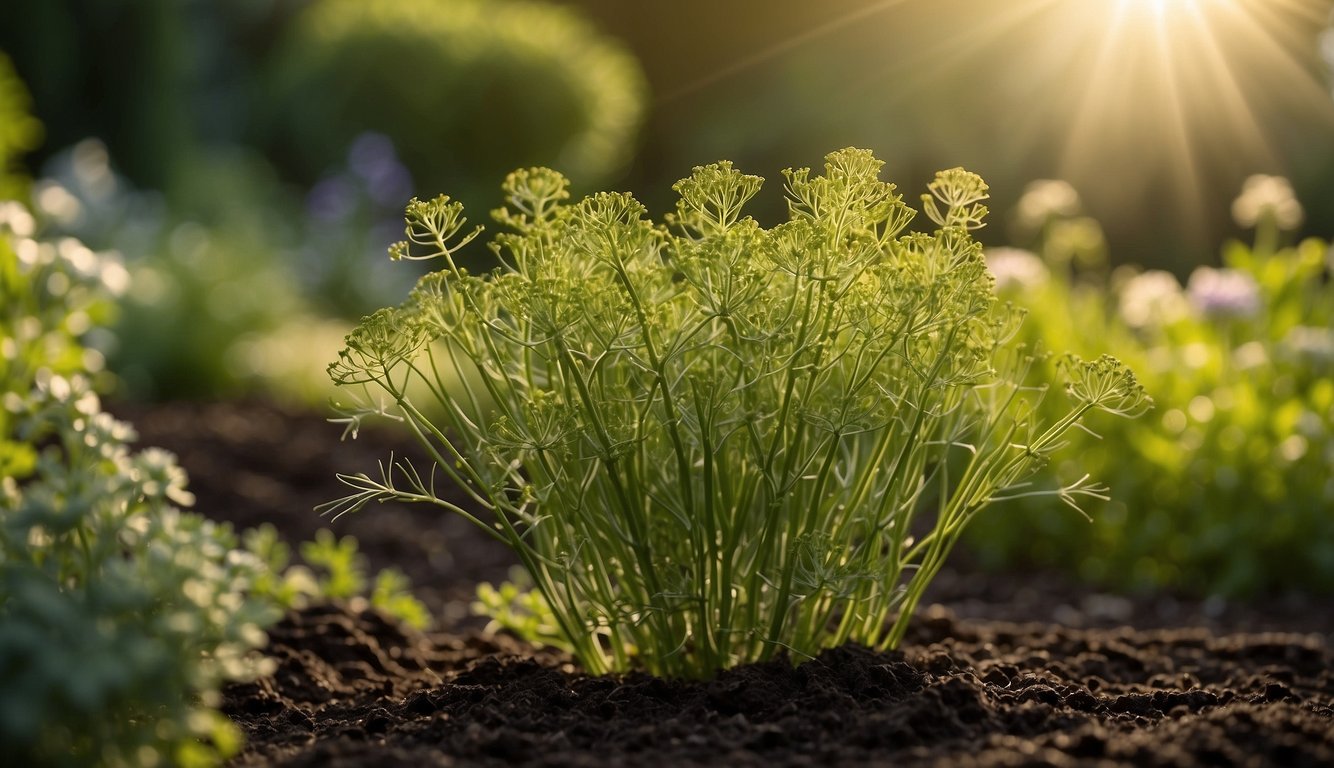
As an herb, dill is a versatile plant that can be used in a variety of ways in landscaping. In this section, I will explore some of the aesthetic uses of dill in garden design, as well as how to create a herb garden with dill.
Aesthetic Uses
Dill is a tall, airy plant that can add a touch of whimsy to any garden. Its feathery leaves and delicate flowers make it an excellent choice for cottage gardens, where it can be used to add texture and movement to borders or mixed beds.
Dill also makes an excellent filler plant for larger landscapes, where its height can be used to add vertical interest and create a sense of scale. It can be used to soften the edges of paths or walkways, or as a backdrop for other plants in a mixed border.
Creating Herb Gardens – How to Propagate Dill?
If you’re interested in creating a herb garden, dill is an excellent choice. It’s easy to grow, and its delicate flavor makes it a versatile addition to your culinary arsenal.
When planning your herb garden, consider grouping dill with other herbs that have similar growing requirements, such as parsley, cilantro, and basil. You can also use dill to create a focal point in your herb garden by planting it in a large container or as a standalone plant.
To ensure that your dill plants thrive, make sure to plant them in well-draining soil, and provide them with plenty of sun and water. You can also use organic fertilizers to help promote healthy growth and ensure that your plants produce an abundance of flavorful leaves and flowers.
Dill is a versatile herb that can be used in a variety of ways in landscaping. Whether you’re looking to add a touch of whimsy to your garden or create a herb garden for culinary use, dill is an excellent choice that is sure to please.
Troubleshooting Common Issues – How to Propagate Dill?
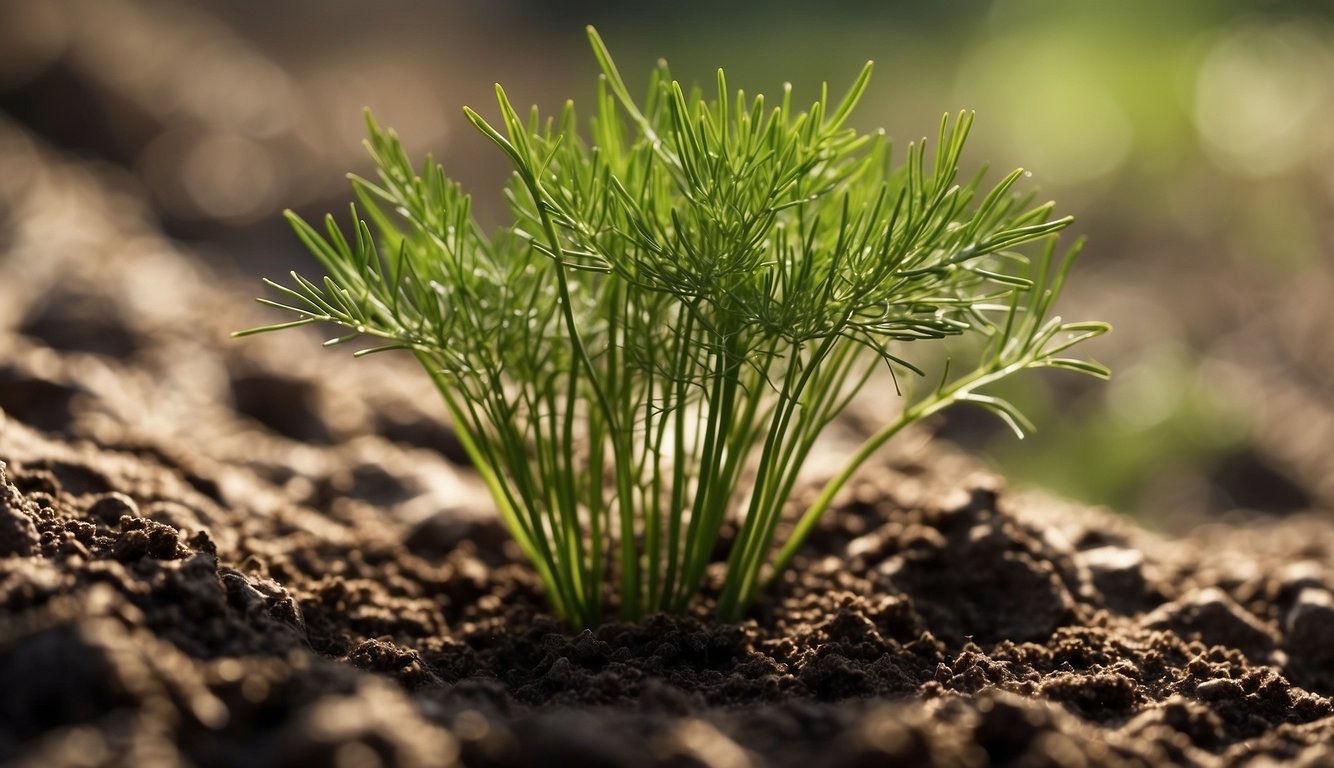
Overcoming Poor Germination
If you’re having trouble with poor germination, there could be a few reasons why. First, make sure you’re using fresh dill seeds. Old seeds may not germinate as well. Also, make sure you’re planting the seeds at the right depth. Dill seeds should be planted about ¼ inch deep in well-draining soil.
Another common issue is that the soil may be too dry or too wet. Make sure the soil is consistently moist but not waterlogged. You can also try covering the seeds with a thin layer of vermiculite or perlite to help keep the soil moist.
Addressing Slow Growth – How to Propagate Dill?
If your dill plants are growing slowly, there could be a few things going on. First, make sure the plants are getting enough light. Dill plants need at least 6 hours of direct sunlight each day. If they’re not getting enough light, consider moving them to a sunnier location or supplementing with grow lights.
Another issue could be the temperature. Dill plants prefer temperatures between 60-70°F (15-21°C). If it’s too cold or too hot, the plants may not grow as quickly.
Dealing with Bolting
Bolting is when the dill plant starts to produce flowers and seeds prematurely. This can happen if the plant is stressed, such as from being too dry or too hot. To prevent bolting, make sure the plants are getting enough water and are not exposed to extreme temperatures.
If your dill plant has already started to bolt, you can still use the leaves and seeds. However, the flavor may not be as strong as it would be if the plant had not bolted. You can also try planting a new batch of dill seeds in the fall for a second crop.
Overall, troubleshooting common issues with dill propagation is relatively easy if you pay attention to the soil, water, light, temperature, and humidity. With a little bit of care and attention, you can grow healthy and flavorful dill plants in your garden.
Dill and Sustainability – How to Propagate Dill?
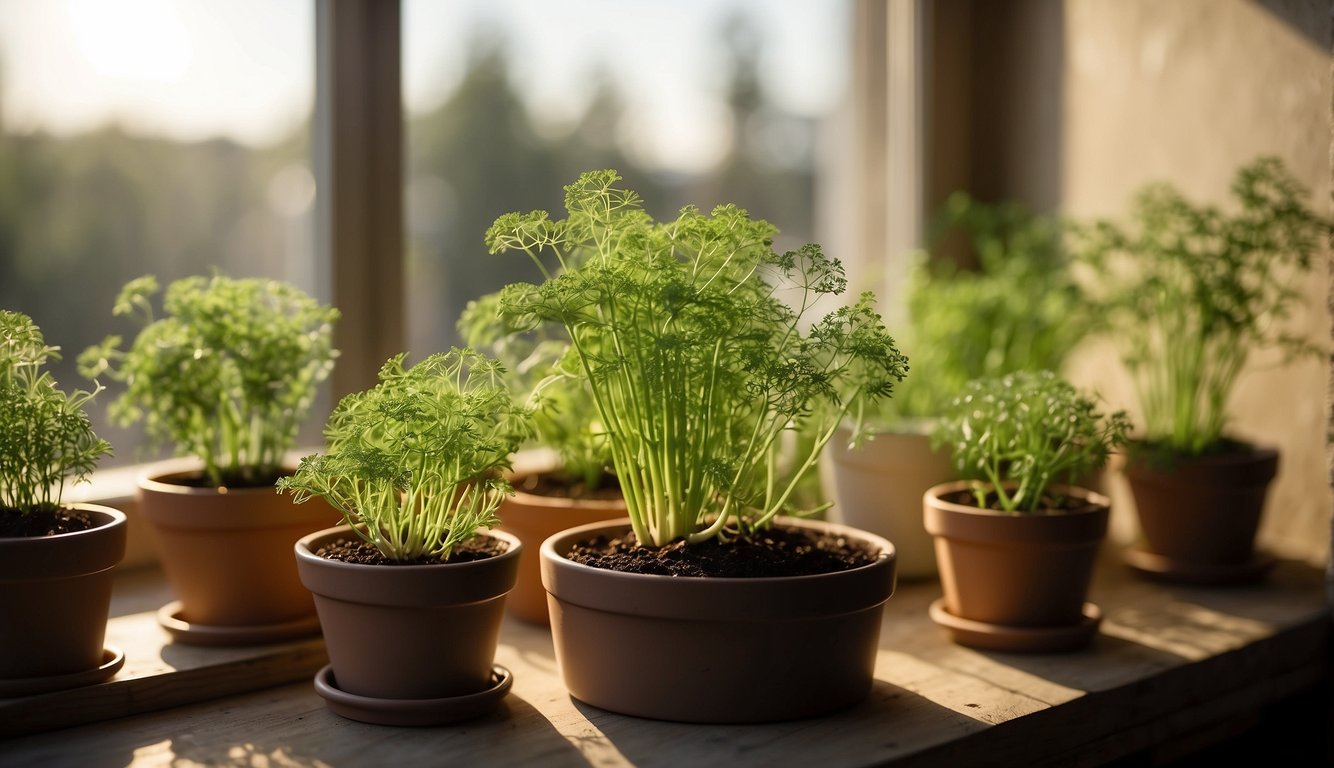
As someone who loves gardening and cooking, I am always looking for ways to make my gardening practices more sustainable. Dill is a great herb to grow, not only because it’s delicious but also because it’s easy to propagate and maintain. Here are some tips on how to grow dill sustainably.
Water Conservation – How to Propagate Dill?
Water is a precious resource, and conserving it is essential for sustainability. Dill is a drought-tolerant herb that doesn’t require a lot of water. In fact, overwatering can lead to root rot and other problems. To conserve water, I recommend planting dill in well-draining soil with plenty of organic matter. Adding sand to the soil can also help with drainage. When watering, make sure to water deeply but infrequently, allowing the soil to dry out slightly between waterings. This will encourage deep root growth and help the plant withstand drought.
Organic Growing Practices
Growing dill organically is also important for sustainability. Chemical fertilizers and pesticides can harm the environment and pollute water sources. Instead, I recommend using organic methods to fertilize and control pests. For example, adding compost to the soil can provide nutrients for the plant and improve soil health. Companion planting with other herbs and flowers can also help deter pests and attract beneficial insects. For example, planting dill near tomatoes can help deter tomato hornworms, while planting it near marigolds can attract beneficial insects like ladybugs and lacewings.
Growing dill sustainably is not only good for the environment but also for your garden. By conserving water and using organic growing practices, you can enjoy a bountiful harvest of this delicious herb while minimizing your impact on the planet.
Enhancing Flavor and Aroma – How to Propagate Dill?
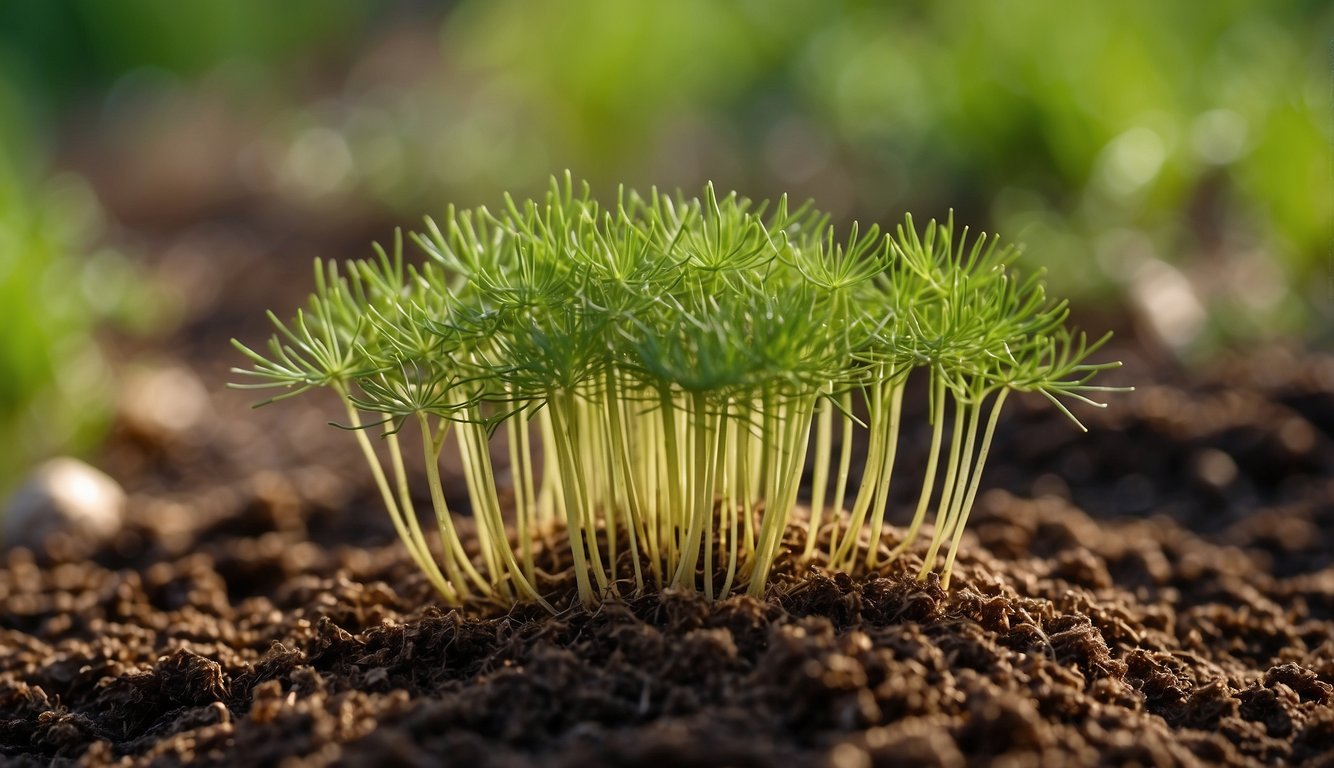
Dill is a versatile herb that can add a unique flavor and aroma to a variety of culinary dishes. Here are some tips to enhance the flavor and aroma of your dill:
Optimizing Growing Conditions – How to Propagate Dill?
To get the best flavor and aroma from your dill, it is important to optimize the growing conditions. Dill requires well-draining soil with a neutral or slightly acidic pH level. It also prefers full sun exposure and moderate watering. Overwatering can lead to root rot and affect the flavor of the leaves. To ensure optimal growth, it is recommended to fertilize the soil with a balanced fertilizer once a month.
Harvest Timing for Peak Flavor
The timing of the harvest can greatly affect the flavor and aroma of dill leaves. Harvesting the leaves when they are young and tender will result in a more delicate flavor and aroma. On the other hand, mature leaves tend to have a stronger flavor and aroma. To harvest, simply cut the leaves from the stem with a sharp pair of scissors.
It is important to note that dill leaves are best used fresh as they tend to lose their flavor and aroma when dried. Therefore, it is recommended to harvest only what you need for immediate use.
In addition to its culinary uses, dill is also known for its aromatherapy benefits. The essential oil of dill has a calming effect and can help relieve stress and anxiety. Therefore, incorporating dill into your recipes not only adds flavor but can also have a positive impact on your overall well-being.
Pptimizing the growing conditions and harvesting at the right time can greatly enhance the flavor and aroma of dill leaves. Incorporating dill into your culinary recipes not only adds flavor but also provides aromatherapy benefits.
Cultural Significance of Dill – How to Propagate Dill?
Dill is an herb with a long history of use in culinary and medicinal applications. It has been cultivated for thousands of years and has played an important role in many cultures around the world. In this section, I will discuss the cultural significance of dill, including its historical uses and its place in world cuisines.
Historical Uses
Dill has been used for its medicinal properties since ancient times. The ancient Egyptians used dill as a soothing medicine, and it was also used in ancient Greece and Rome for its medicinal properties. Dill was also used in traditional Chinese medicine to treat a variety of ailments.
In addition to its medicinal uses, dill has been used for culinary purposes for centuries. It is a popular herb in many cuisines, including those of Scandinavia, Eastern Europe, and the Middle East. Dill has a distinctive flavor that is both sweet and savory, and it is often used to flavor pickles, soups, and stews.
World Cuisines And Dill
Dill is a staple in many world cuisines. In Scandinavian cuisine, dill is used to flavor fish dishes and is a key ingredient in gravlax, a cured salmon dish. Now, in Eastern European cuisine, dill is used to flavor soups, stews, and pickles. In Middle Eastern cuisine, dill is used to flavor rice dishes and is a key ingredient in the spice blend za’atar.
Dill is also a popular herb in Indian cuisine, where it is used to flavor chutneys and curries. In addition, dill is a common ingredient in many Mediterranean dishes, including Greek and Turkish cuisine.
Dill has a long and rich history of use in both culinary and medicinal applications. Its distinctive flavor and cultural significance have made it a staple in many world cuisines.
The Fragrant Link: How to Propagate Dill and The Herb Prof
Let’s delve into the fragrant topic of how to propagate dill and its connection to our herbal haven, theherbprof.com. Ready for a dill-ightful journey?
Firstly, propagating dill is a practice of patience and care. It’s about nurturing a tiny seed into a flourishing plant. Sounds familiar? That’s because theherbprof.com nurtures your curiosity about herbs, helping it grow into a deep understanding and appreciation.
Secondly, both dill propagation and theherbprof.com are about sustainable growth. Just like dill can be propagated sustainably, theherbprof.com promotes sustainable practices in herb cultivation.
Lastly, they both aim to enrich our lives. Dill adds a fragrant touch to our meals, while theherbprof.com adds a fragrant touch to our minds with herbal wisdom.
So, there you have it! How to propagate dill and theherbprof.com are a fragrant pair indeed. They both symbolize patience, sustainable growth, and enrichment. Now, isn’t that a dill-ightful piece of information to share at your next garden party? Keep growing, folks!
References – How to Propagate Dill?
Little Herb Encyclopedia, by Jack Ritchason; N.D., Woodland Publishing Incorporated, 1995
The Ultimate Healing System, Course Manual, Copyright 1985, Don Lepore
Planetary Herbology, Michael Tierra, C.A., N.D., Lotus Press, 1988
Handbook of Medicinal Herbs, by James A. Duke, Pub. CRP Second Edition 2007
The Complete Medicinal Herbal, by Penelope Ody, Published by Dorling Kindersley
Check the Following Articles!
Growing Cucumbers in Grow Bags
Is Bone Meal Good for Potatoes? A Comprehensive Answer
How To Use Diatomaceous Earth For Ants Control
Frequently Asked Questions – How to Propagate Dill?
What is the best method to propagate dill from cuttings?
The best method to propagate dill from cuttings is to select healthy cuttings that are about 4-5 inches long with at least 3 sets of nodes along their length. Make sure they are free from disease or pests before snipping them off with sharp scissors. Disinfecting blades between cuts is also recommended for cleanliness sake. Once the cuttings are taken, dip the cut ends in rooting hormone and plant them in moist soil. Keep the soil moist and place the pot in a well-lit area, but not in direct sunlight.
Can dill be successfully grown from its roots, and if so, how?
Yes, dill can be successfully grown from its roots. To do this, carefully dig up the plant, making sure to keep the roots intact. Cut off the top of the plant and replant the roots in a new location. Water well and keep the soil moist until the plant is established.
What are the necessary steps to grow dill from seed in pots?
To grow dill from seed in pots, fill a pot with well-draining soil and sprinkle the seeds on top. Cover the seeds with a thin layer of soil and water well. Place the pot in a well-lit area, but not in direct sunlight. Keep the soil moist and the temperature around 60-70°F. The seeds should germinate within 7-14 days.
Is it possible to propagate dill in water, and what is the process?
Yes, it is possible to propagate dill in water. To do this, take a cutting from a healthy dill plant and place it in a jar of water. Make sure the cut end is submerged in the water and change the water every few days. Once the roots have grown to about an inch long, transplant the cutting into soil.
How can one propagate dill indoors for year-round growth?
To propagate dill indoors for year-round growth, start with a healthy plant and take cuttings as needed. Plant the cuttings in pots filled with well-draining soil and place them in a sunny window. Water the plants regularly and fertilize once a month with a balanced fertilizer.
Does dill need full sun exposure to thrive, or can it grow in partial shade?
Dill prefers full sun exposure but can also grow in partial shade. However, if grown in partial shade, the plant may not produce as much foliage and may be more susceptible to pests and diseases.
